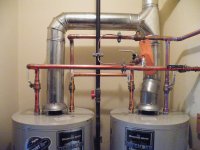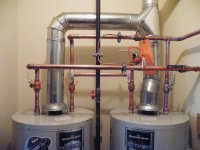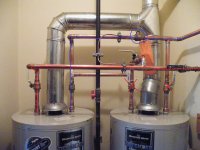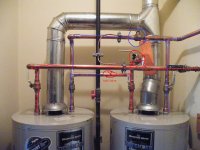Had to draw out flow paths to make sense as it was hurting my head:laughing:
His current flow of water
View attachment 460859
Using only the right tank. (circled valves need opened, X'ed need closed)
View attachment 460860
Only left tank (same thing with circled and X'ed valves)
View attachment 460861
And for parallel, only one valve would need added to prevent the mixing of hot and cold between the two tanks. Closed for parallel, open for everything else
View attachment 460862
Dont know the science or reasoning behind either setup. Never researched it, But I would think parallel would preform better. Say you have 2 40gallon heaters, total hot water is 80 gallons. So no matter what, you will get 80 gallons before you run out. But then theres the first hour rating and all. Because as you use water, the incoming cold water will start to heat up, and by the time you run the tank empty, you have warmed up some of the water so you get a little more than 80 gallons.
So, on a series system, with 40 gallon tanks, you have to pretty much empty the first tank and start feeding the second tank with colder water before it will start to heat.
Whereas a parallel system, once you use a little hot water off the top, both tanks will fire and be heating. So to oversimplify, if you have a pair of 40's with a 50gal 1st hour rating.......I think the total system 1st hr rating would be more like 50+40 = 90. With parallel I think you would be closer to the full value of 100.




